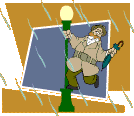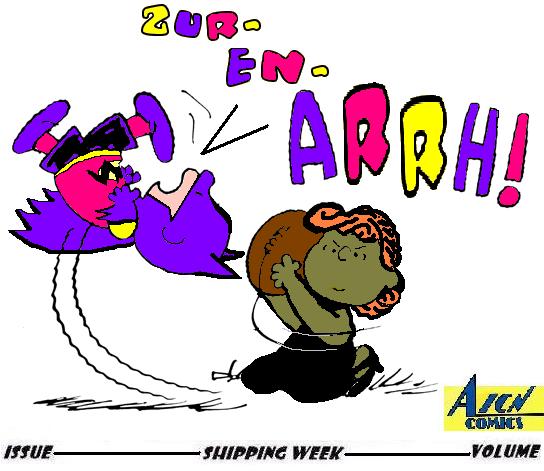
| #17 | 9/2/09 | #8 |
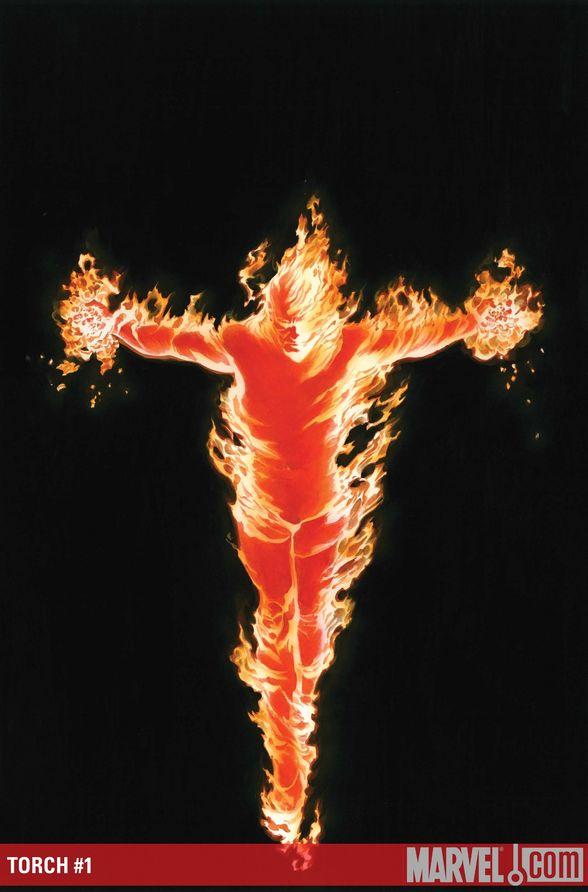
THE TORCH #1
Story: Alex Ross & Mike Carey Script: Mike Carey Artist: Patrick Berkenkotter Color Art: Carlos Lopez Publisher: Marvel Comics/Dynamite Reviewer: Matt Adler
Yeah, “The Torch”. Not “The Human Torch”, because this series is about the android from the 1940s. Personally, I always liked the balls of naming an artificial man the “Human Torch” but I guess if they’re going to attempt to relaunch the character, they want to distinguish him from Johnny Storm.A brief rundown of the character’s history: the original Human Torch was one of the first Marvel superheroes, an android created in the Golden Age of Comics (i.e. the World War II era) by a scientist seeking to create artificial life. For unknown reasons, his artificial man burst into flame on activation, and flew the coop, eventually developing his own identity as Jim Hammond and battling Nazis alongside the likes of Captain America and the Sub-Mariner. After the the war ended, comics sales slumped, and all three superheroes eventually disappeared.
When Stan Lee got the idea to do the Fantastic Four, he decided to bring back the Torch, although only keeping the name and powers--the new Torch was a kid named Johnny Storm. But as time went by, the original Torch was brought back, and hung around the Marvel Universe for several years until finally being blown up a few years ago in a series called NEW INVADERS. But you can’t keep a good android down, right?
This new series leads directly out of the AVENGERS/INVADERS series by Alex Ross and Jim Krueger. As with many of his comics projects these days, Ross is only providing covers and co-plotting here; Patrick Berkenkotter does the interiors (he also worked on some of the AVENGERS/INVADERS issues). And this time around, Ross teams with Mike Carey as co-plotter and scripter.
This first issue actually doesn’t feature much of the Torch, because, well, he’s dead. Instead it focuses on his old sidekick Toro, who was brought back to life at the end of AVENGERS/INVADERS by the Cosmic Cube. Toro didn’t ask to be brought back to life, and he’s kind of lost in the 21st century, so he receives some guidance/harassment from the Golden Age Vision, a being from another dimension where smoking in public places is still legal. Eventually Toro decides to hunt down the guy who originally killed him: the Fantastic Four’s old foe, the Mad Thinker.
The Mad Thinker has had widely varying portrayals over the years, but here he’s taken back to basics; he’s a brilliant, arrogant, amoral scientist who does what he does mostly for the intellectual challenge (but isn’t above cashing in). He’s nicely portrayed as 10 steps ahead of everyone else, including Toro who blunders in thinking he’s going to take the Thinker down easily.
The Thinker then becomes the vehicle to delve into the science behind Toro’s powers, and perhaps more importantly, those of his former partner. When I first discovered the Torch and Toro in the pages of the old Invaders comic, I thought they must have some connection; I mean, what are the odds of two unrelated guys with identical flame powers becoming a crime-fighting duo? But no, back then we were told it was all just coincidence, they were completely unrelated; the Torch was an android with artificial powers, and Toro was a mutant who just happened to develop the same powers. Okay.
A lot of modern retcons don’t work for me, but where Ross and Carey are going here makes a lot of sense. They address the question head on: what ARE the odds of this just being a coincidence? Pretty slim as it turns out, and the Thinker quickly uncovers a crucial clue: implanted in his body, Toro has some of the very same artificial cells that make up the Torch’s body. So the seeds are planted for the Torch’s return.
Berkenkotter does a nice, clean job with the art, and his rendition of the Mad Thinker as the extremely creepy mad scientist is perfect. The script by Carey is very tight, moreso than AVENGERS/INVADERS (although to be fair, that had a lot more characters to deal with). Ross and Carey have set up a compelling mystery, and if they can keep this level of interest throughout the series, they may be successful at reintroducing Jim Hammond to the Marvel Universe.
In most places, Matt Adler goes by the name his mother gave him, but occasionally uses the handle "CylverSaber", based on a character he created for the old DARK FORCES II: JEDI KNIGHT game (one hint of his overweening nerddom). He currently does IT and networking support for the government of Nassau County, NY, but his dream is to write for a living, and is in the process of figuring out how to get publishers to give his stuff a look. In the meantime, he passes the time by writing for AICN, CBR, and a few other places. He has also written for MARVEL SPOTLIGHT magazine.
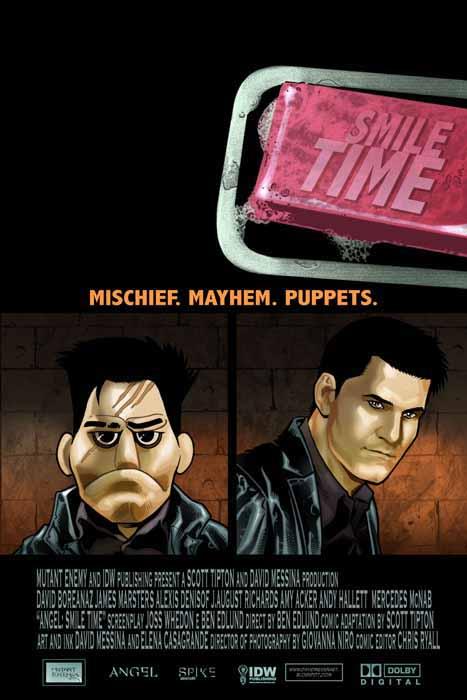
ANGEL: SMILE TIME HC
Written by: Scott Tipton, Jeff Mariotte, Brian Lynch Art by: David Messina, Elena Casagrande, Stephen Mooney, Franco Urru Published by: IDW Publishing Reviewed by: Baytor
I wonder what it says of me that I simply could not walk past this book without buying it. It’s not like I don’t already own the “Smile Time” episode on DVD and I even own the SPIKE: SHADOW PUPPETS graphic novel that makes up the back half of this book. There is one short story included that I don’t already own, but I didn’t realize it was in there until I was already on my way to the checkout counter.No, I saw Puppet Angel and smiled so much I had to buy it. For those of you who haven’t experienced “Smile Time”, it is one of the most utterly charming episodes of ANGEL, in which our moody vampire investigates a demonic edutainment puppet show and, much to everyone’s surprise, gets turned into a puppet. Once more, he has the proportional excitability of a puppet his size, so he reacts to his newfound felt persona in enormously humorous ways, which often include hiding under his desk or just flipping out at people.
Saying the words “you’re a wee puppet man” to an ANGEL fan is like saying “it’s only a flesh wound” to a Monty Python fan…and you will pay dearly for getting either of them started.
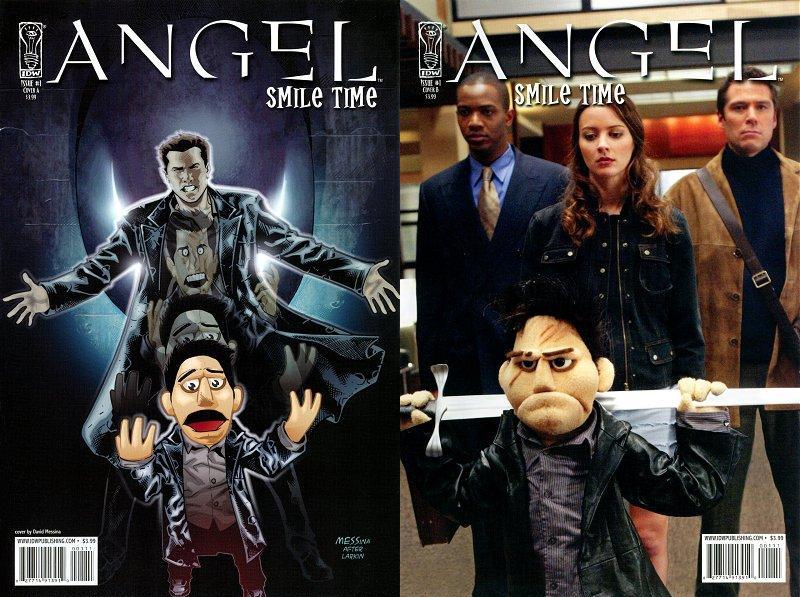 But there’s absolutely no reason for a comic adaptation of the story. It’s a very well done adaptation and three issues is the absolutely perfect length to capture the nuances of the story, but there’s no way it can do justice to the small humorous flourishes of the original story, such as Angel puppet being literally hurled at people in fights scenes, with its little arms and legs flailing lifelessly. Or Spike being unable to stifle a smile after he’s just had his ass kicked by a puppet. The entire audience of this book is likely people like me who see Puppet Angel and think “must buy”, and IDW, thankfully, didn’t insult us by putting out some horribly drawn POS.
But there’s absolutely no reason for a comic adaptation of the story. It’s a very well done adaptation and three issues is the absolutely perfect length to capture the nuances of the story, but there’s no way it can do justice to the small humorous flourishes of the original story, such as Angel puppet being literally hurled at people in fights scenes, with its little arms and legs flailing lifelessly. Or Spike being unable to stifle a smile after he’s just had his ass kicked by a puppet. The entire audience of this book is likely people like me who see Puppet Angel and think “must buy”, and IDW, thankfully, didn’t insult us by putting out some horribly drawn POS.But even if you’re not one of us, there’s still a very good reason to buy this book. That reason is SPIKE: SHADOW PUPPETS. While the “Smile Time” adaptation is hampered a bit by the low-budget nature of the television show (giving us lots of static shots of people hanging out in office buildings), the Spike sequel goes as big as big can go, with Spike’s gang being assaulted by hordes of ninja puppets in Tokyo. The whole affair is done with tongue firmly in cheek (often mocking fans on the internet obsessed with canon) and reaches absurd heights when the entire cast of ANGEL gets puppetized… even that weird fish thing from ANGEL: AFTER THE FALL.
The character of Spike works best if you keep him away from deep emotional issues and put him in stories that play to his strengths of slightly inept ass-kicking and cracking jokes, and Bryan Lynch excels at putting him into situations where he does both. And any comic that does a puppet homage to THE GODFATHER has serious cool points in my book.
Seriously, wee puppet men. You know you want it.
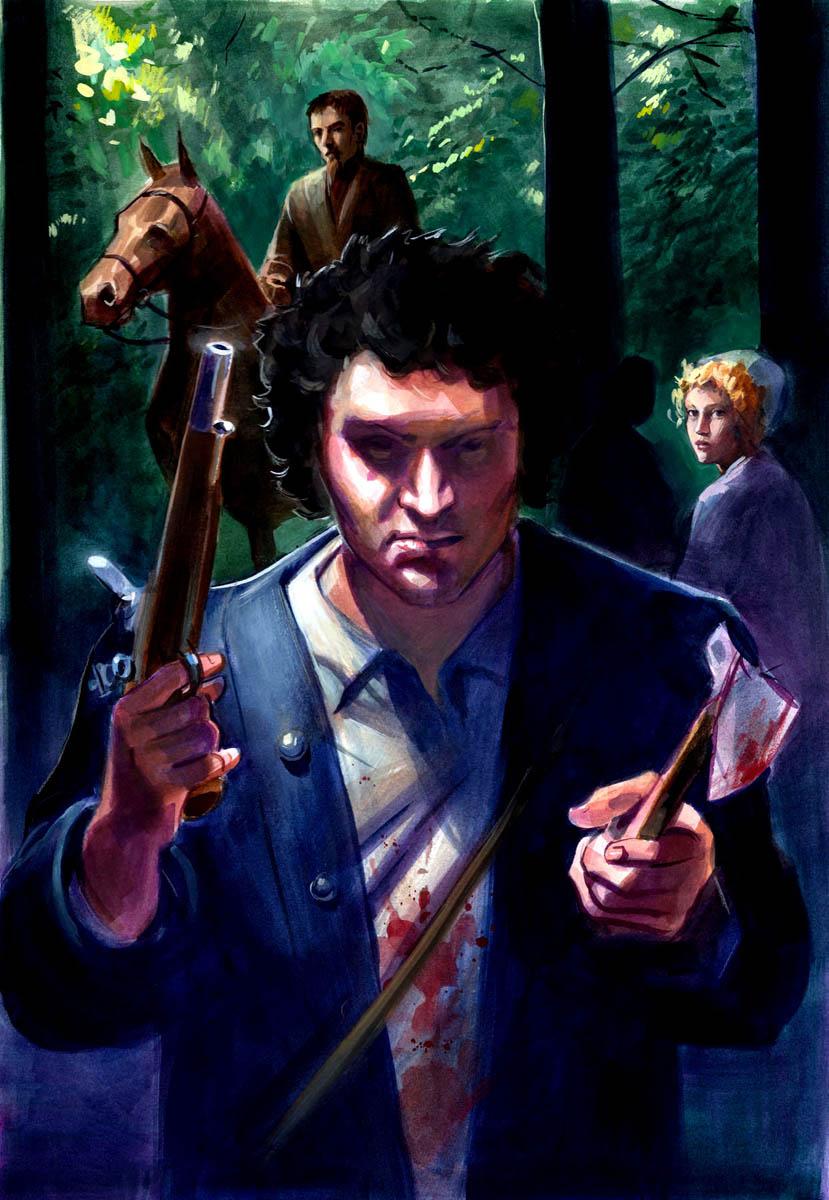
Early Review of HARPE OGN
Writer: Chad Kinkle Art: Adam Shaw Publisher: Cave In Rock Release Date: Available to order in this month’s Previews! Ambush Bug
I’m a sucker for true crime books. There’s just something creepy about reading about these horrific events that actually happened. I can watch campy horror or sci fi fantasy all day long, but if it’s something based in fact, then it really gets under my skin.HARPE is definitely a comic that gets under one’s skin and crawls like mad. Written by Chad Kinkle, the story follows a pair of murderers who wreeked…wrought…wraut…whatever… havoc across Middle America in the early 1800s. The story has an OCCURRENCE AT OWL CREEK BRIDGE theme going on from the beginning, where two criminals are being hung for crimes the reader doesn’t know about yet. In the instant that the rope tightens, one of the crooks narrates the detailed tale of Harpe’s murder spree. Kinkle does a good job of making us dislike the main character. He murders without conscience: women, children, the weak, animals. None of them have any pity from him. Still, the story is compelling because, after witnessing these horrible crimes Harpe commits, you want to hang in there and see him get what’s coming to him. Some of the crimes, which I won’t go into in too much detail here, are pretty wince-inducing, but Kinkle and artist Adam Shaw do their best to show these crimes not in a glamorizing way, but in a cold hard facts sort of manner. By doing this, the shock of the violence hits you all the more and resonates long after the pages have been turned. One scene in particular involving a baby and another involving two people tied to horses are going to be etched in my brainpan for a while.
Artist Adam Shaw does a great job with this book. His black and white and gray panels look to either be done in pencils or charcoals. These are textured panels that look authentic and aged. The action Shaw depicts is memorable in the angles he chooses to use. And the aforementioned violence, although gruesome, is pretty damn beautiful when you see it done by Shaw’s capable hands.
HARPE is an original graphic novel that clocks in at about 94 pages. The book reads quick because of Kinkle’s capable way of pulling the reader in and Shaw’s deft artistry making even the ugliest of actions stand out and stamp themselves in your mind. You’re not likely to forget this story after putting it down.
Ambush Bug is Mark L. Miller, reviewer and co-editor of AICN Comics for over eight years. Check out his short comic book fiction from Cream City Comics’ MUSCLES & FIGHTS VOL.3 and MUSCLES & FRIGHTS VOL.1 on his ComicSpace page. Bug was interviewed here and here at Cream City Comics. Look for more comics from Bug in 2009 from Bluewater Comics, including the sequel to THE TINGLER for their VINCENT PRICE PRESENTS ongoing series in stores September30th, 2009 and VINCENT PRICE PRESENTS WITCHFINDER GENERAL and ROGER CORMAN PRESENTS DEATHSPORT to be released in early 2010.
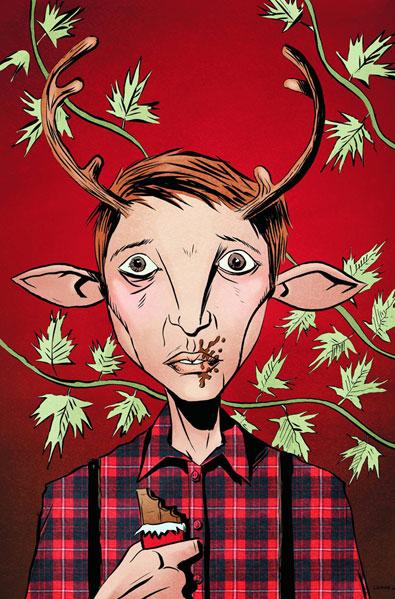
SWEET TOOTH # 1
Words and art by Jeff Lemire Published by DC Vertigo Reviewed by Stones Throw
I now know how that guy in the movie queue in ANNIE HALL who gets berated by Marshall McLuhan feels. Vertigo does many good things, not the least of which is publishing quality comics that don’t feature zombies or superpowers. But they also make their writers (or writer-artists, like Jeff Lemire) write a short column about their comic in the back of each #1. I can remember when Marvel would give writers the letter column of the first issue in which to talk about their new series and what they had planned, but in today’s Vertigo comics that column is a slim sidebar on the editorial page, meaning there’s little space to say anything interesting or insightful. Mostly it just comes across as self-promotion, and when you’ve finished a comic book, you don’t want to read an advert for it, right? Like if they showed the trailer for the movie during the end credits. Harvey Pekar is the only guy I can think of that wrote anything memorable in that short space, and he was just mocking his editor for making him do it.Before you reach the editorial page, though, SWEET TOOTH has a cover that will let you know instantly whether you want to buy it or not. The head and shoulders of a young boy wearing a plaid shirt and with the antlers and ears of a deer fill the illustration, his guilty-looking eyes directly confronting the unsuspecting comic book fan as he peruses the racks. Adding a strange, enticing aspect to the image, the kid (which is a word for baby goat) chews on a candy bar. Like a single panel cartoon, the title provides the punch line: SWEET TOOTH. It looks spooky, it looks American Gothic, it’s almost reminiscent of Charles Addams. I thought of Charles Burns’ graphic novel BLACK HOLE, which featured teens growing animalistic tails, but the plaid shirt and leaves suggest a tone that’s almost rural. Like that book the character suggests loneliness and alienation: the haircut, candy bar and shirt say “average American lad” while the antlers and his stare tell you that’s what he can never be. The chocolate is an illicit thrill, something that shouldn’t be his. You instantly want to open the comic and see what he’s staring at. Who is this deer-boy? How did he get like that? What is the significance of his SWEET TOOTH?
Man-beast hybrids have been a part of fiction almost since stories began, so an ongoing series about one is a great idea. Lemire’s art and storytelling is so impressive that if the cover doesn’t tell you everything you need to know about Gus, the deer-boy with the sweet tooth, then you’re familiar with him by the first page, a dream sequence in which, in tears, he’s chased by a hunter through the woods. Gus wakes up and we start to see his life with his Dad in a secluded cabin somewhere in Nebraska. Out in this lonely wilderness, pagan imagery (deer-men like Gus, wood spirits, the changing of the seasons represented in one double-page spread) mix with the Cross and talking to God. Lemire’s art, already seen in his original graphic novel for Vertigo, THE NOBODY, evokes the shelter of Gus and his Dad’s cabin, thick trees, animals, and empty, snow-covered landscapes all with equal flair, while lines like “Dad says I look like my mom. But I ain’t never seen her” and details like the candy bars Gus keeps finding add some weird humor and keep us asking questions. Gus is a narrator who doesn’t know the whole story.
Compared to the strange and haunting visuals and enigmatic storytelling, the actual plot is less interesting, reminding me of M. Night Shyamalan’s crappy movie THE VILLAGE. Perhaps a better reference is Cormac McCarthy’s novel THE ROAD. Dad dies of what seems like radiation poisoning and, true to genre, the scary figure from Gus’s dreams turns out to be his protector rather than destroyer, saving him from two hunters who had been baiting him with chocolate, hoping to cook and eat him, but not before they shoot a deer in front of him.
All together, the first issue didn’t disappoint my speculation on what a comic featuring deer-men and chocolate might be about. Cue the editorial page and the writer-artist starts using words like “Bambi meets Mad Max”, “post-apocalyptic”, “action-adventure”, “road movie” and I start feeling like I’m being flecked by Marshall McLuhan’s spittle. Jeff Lemire talked up the exact aspects of his comic that I was least interested in. The one-eyed, godless tough man who kills the redneck hunter seems a little too close to the Clint Eastwood haunted killer stereotype and his and Gus’s journey to “the Preserve” seems like a rather too generic plot. I’m left asking, what about the series I was imagining about a deer-boy hybrid and his love for chocolate?
Despite quashed hopes of a title that could be to deer and candy what AMERICAN VIRGIN was to sex, SWEET TOOTH is a book that I’ll continue buying thanks to Lemire’s great, Gothic, Dean Haspiel-esque art and the sheer strangeness of its protagonist. Meanwhile I’ll hope that Lemire’s writing manages not to dull the book’s unique edge and keeps it at a safe distance from standard science fiction tropes.
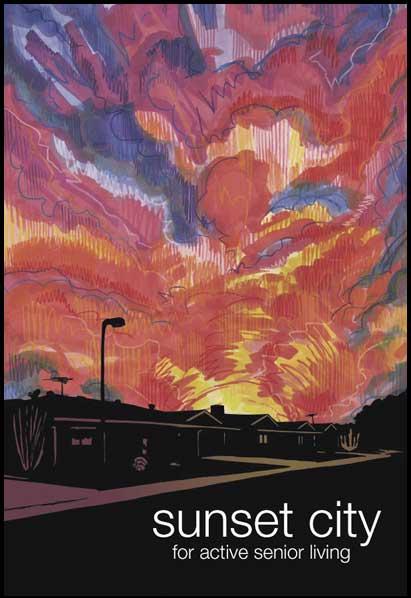
SUNSET CITY OGN
Writer/Artist: Rob Osborne Publisher: AIT Planet/Lar Reviewer: Optimous Douche
SUNSET CITY was more than a casual read, it’s an experience that crawls under your skin and slowly takes root. Osborne uses the façade of the seemingly cheery 55+ community, Sunset City, to explore several societal woes that will immediately resonate no matter what age demographic you choose to place yourself into.On one level SUNSET CITY serves as a cautionary tale to the dangers of the idle mind and perpetual malaise. Let’s be honest, several generations ago sixty was old. Thanks though to the wonders of modern science, we have not only extended our collective life-spans, but the quality of that life has greatly improved. Sadly, large corporations and actuarial tables still treat these healthy senior adults as the walking dead, addle minded burdens of society. The story’s protagonist, Frank, is a recent victim to this societal ageism. Having lost his wife to cancer and his job to improved scales of efficiency, he searches for a purpose in life beyond shuffle board, bingo, centennial birthdays and becoming a Wal-Mart greeter. He is afraid of the inevitability of dying, but he also fears fully embracing life. Whether survivor’s guilt or simply buying into the circumstances that make him believe his inevitable end is just around the corner, he has condemned himself to simply spending his days with his pug and praying for a sign…of anything.
Osborne effectively rips from recent headlines across the country as fodder for The Sunset Citizen, Sunset City’s newspaper. These newspaper snippets help to not only drive the story forward, but also serve to add balance that this is not a propaganda piece commissioned by the AARP. Take for instance the story of one old-timer that mows down 12 people at a street fair when he confuses his gas and brake pedals. A story like this is then juxtaposed with the recent release of a man who killed his children and was let off scot-free because of a police procedure bumble.
While this is Frank’s story, Osborne rounds out the book with an eclectic cast of characters that prove no matter how old we are the same social stratums we despised (or revered) in High School apply to our dying days; the prom queen now community President, the frat-boy perpetually taking life by the balls, and the sweet wholesome girl next door provide Frank with brief respites, but also serve to show at the end of the day we are only left with ourselves.
SUNSET CITY is exactly what comics or any other form of entertainment should be trying to accomplish; forcing us to ask the larger questions, whether the back-drop is a retirement community or Metropolis. When you can walk away from a piece questioning your own perceptions and mores, while being simply astounded at the different directions the piece moves in, you have transcended from a funny book to an actual piece of literature. Finally, if any of you are like me and have perpetually wondered what purpose the shriveled Wal-Mart greeter serves as they hand you a shopping cart in twice the time you could have gotten it yourself, you will be damn happy they chose that course to fill their remaining days instead of going Frank’s route.
When Optimous Douche isn’t reading comics and misspelling the names of 80’s icons, he “transforms” into a corporate communications guru. "What if the whole world had superpowers? Find out in the pages of Optimous’ original book AVERAGE JOE. Read the first full issue on Optimous’ New Blog and see original sketches by fellow @$$hole Bottleimp. If you are a publisher or can help these guys get AVERAGE JOE up, up, and on the shelves in any way, drop Optimous a line."
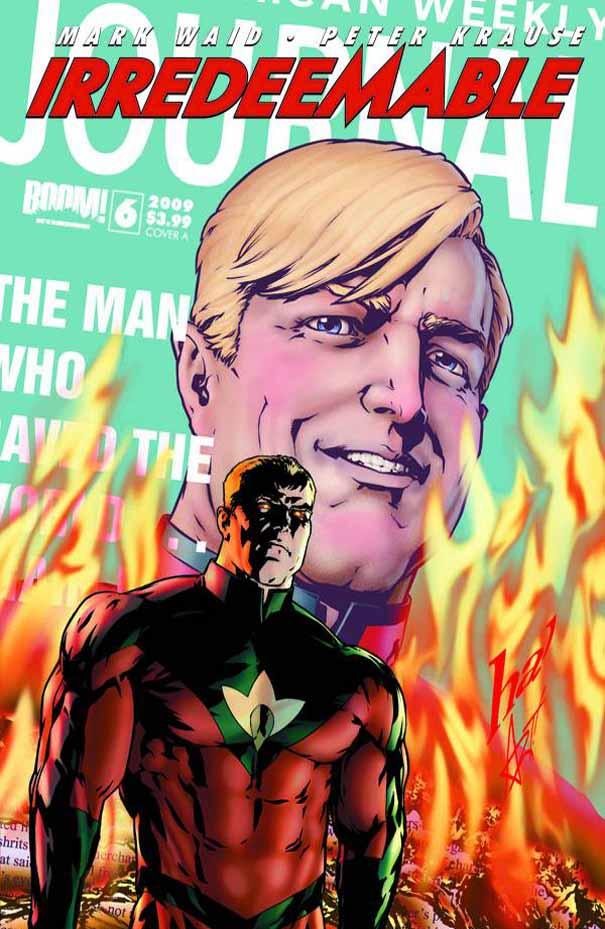
IRREDEEMABLE #6
Writer: Mark Waid Artist: Peter Krause Published by: BOOM! Studios Reviewed by: BottleImp
The hook. It’s an essential part of strong storytelling. The hook is necessary to grab the audience’s attention, to pique the interest of the audience and make them sit up and say, “Wow, that’s really something…I can’t wait to see/read/hear what happens next!” Of course, there’s only so much that the hook can do. If the subsequent story ends up being dull and uninteresting, the excitement sparked by the initial hook will soon fade and disappear, as most likely will the audience.Which brings me to IRREDEEMABLE. Talk about an amazing hook: we were dropped right in the middle of a Superman gone bad, killing members of the Paradigm, his former teammates, and wreaking destruction on the entire planet. The readers had no clue as to the circumstances of the Plutonian’s moral one-eighty, merely tantalizing hints that showed a demigod being pushed ever so gently towards his breaking point by the ignorance and ingratitude of the mere mortals. After that first issue, I was eagerly looking forward to reading more about the straws that broke the Plutonian’s back. But with each subsequent issue, my initial excitement for this series slowly ebbed away.
Call it the LOST syndrome—remember back before that television show had a scheduled end date, when the writers and producers didn’t want to reveal too much of the mystery too soon? The early seasons were full of episodes that ended up feeling pointless and redundant—viewers didn’t care about Sun having an affair with her English tutor, they just wanted to know what was in the hatch, goddammit!
I’m feeling that same problem with IRREDEEMABLE. Mark Waid obviously doesn’t want to show his cards this early in the game, so instead we get the Plutonian being evil as his ex-teammates scramble to find some way of stopping the most powerful being on Earth. That’s all well and good, except that aside from knowing next to nothing about the Plutonian, the reader knows even less about the heroes intent on stopping him. Without knowing these characters (aside from being able to recognize names and powers…well, some of their powers, anyway) there’s no emotional investment in their struggle. Even when Waid manages to drum up some interest in their panicky search for the Plutonian’s possible Achilles’ Heel, you never really feel that “in the moment” rush that comes when you identify with the protagonists. The interest the reader feels is more…clinical, I guess would be the best way I can put it; the kind of interest that makes you say, “That’s interesting,” and then forget all about it. By keeping IRREDEEMABLE’s mystery hidden from the reader, Waid is actually keeping the reader at a distance from his work.
That being said, however…
This issue gives me hope that this series might live up to the promise of its hook. Their location given away by one of the Modeus doppelgangers (the Lex Luthor to the Plutonian’s Superman) and the Plutonian speeding his way towards them, the Paradigm’s surviving members escape to the only place in the world that they know the Plutonian ISN’T—his secret Citadel (i.e. the Fortress of Solitude). There they make a gruesome discovery that ties in neatly with this issue’s flashback to an earlier Paradigm adventure, and that has finally made me eager once more for the next issue to arrive. After four issues of the Plutonian alternating between insane super-villainy (destroying Singapore) and sick psychosis (forcing people to act out his twisted sex scenes), the mystery that made this series so enticing has returned. Hopefully the plot and the cast will continue to be developed so that this sense of urgency and excitement can be maintained.
And not to beat a dead horse, but Peter Krause’s artwork just isn’t helping on the “maintaining excitement” front. His work is like fiber cereal of the comic world—it gets the job done and keeps you pooping, but it’s nothing that you get any satisfaction out of consuming. His character designs are rather bland (although to be fair, colorist Andrew Dalhouse shoulders part of the blame for his over-reliance on blues and purples for clothing colors) and aside from the drawing style, there’s a lack of storytelling clarity that sometimes pops the reader out of the story. In this issue, for example, the Plutonian is skimming over a body of water, searching for the Paradigm’s hideout. “Hidden right out in the open. Clever,” he says, then apparently breaks into the hideout. Was the hideout an island? In the water? Invisible? I can’t say for sure, and it’s this kind of visual confusion that can end up cooling down the reader’s experience just as it was beginning to warm up. More and more I’m thinking that a change of the art could bring the series up to a higher level of entertainment.
Even though it’s not quite back up to the excitement of that marvelous hook, Waid and Co. are slowly making IRREDEEMABLE an enjoyable read…we’ll see how I feel about it next month.
When released from his Bottle, the Imp takes the form of Stephen Andrade, an artist/illustrator/pirate monkey painter from the Northeast. You can see some of his artwork athere. He’s given up comics more times than he can remember. But every time he thinks he's out, they pull him back in.
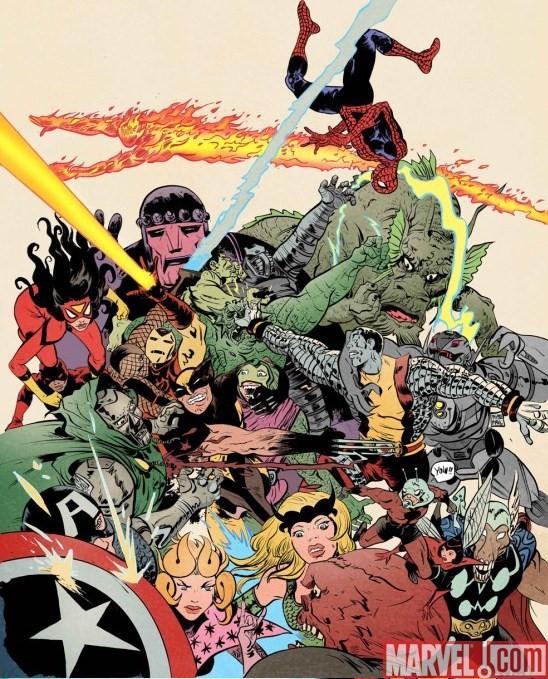
STRANGE TALES #1 (of 3)
Writers & Artists: Various Publisher: Marvel Knights Comics An accidental Two In One Review by Ambush Bug & Humphrey Lee
Note: Sometimes when two reviewers want to review the same thing, we set up a steel cage in the back yard of @$$Hole HQ and wrassle it out with chainsaws and torches and spearguns Thunderdome-stylee to decide who gets to review the book in question. After twelve hours of such carnage, if the two reviewers are still standing, we just say eff it and post both reviews…okay, we admit it, two of us did cheapies on the same comic, so we ran both. Sue us.HUMPHREY: While on the overall I'm getting a little tired of anthologies - in the past year alone I've read two POPGUN volumes, COMIC BOOK TATTOO, FLIGHT, and now WEDNESDAY COMICS - I still felt compelled to pick this up. Maybe it's because it's been talked about for TWO FUCKING YEARS NOW!! and I just needed to see it come to fruition, or maybe it was just the sweet Paul fucking Pope cover that made me pull the trigger. Either way, this has finally come to the newsrack, and it was well worth the wait. Now, like with all anthologies you take the bad with the good, but there was far more of the latter than the former. The Paul Pope opener with Lockjaw and the Inhumans was simply amazing, as you'd expect from Mr. Pope. The Perry Bible Fellowhip splashes - which I had no idea were in here - were also nothing short of fantastic and I hope there's more in the next two issues. The Johnny Ryan pages were also pretty amusing, as ws Kochalka's Rainbow Hulks story, and after that it was kind of a mixed bag, even though the names creating them were still a big deal in their own right, just seeing them do a Marvel project. I wasn't as impressed by Bagge's "The Incorrigible Hulk" as I was hoping to be, but it was still fun at times. Overall, I'm just glad this project has finally come to a head, and it had a much better success rate than the majority of anthologies I have read in my time. I'm kind of glad this is just a three issue mini though, as that way the novelty won't wear off so fast, though I do hope this becomes some sort of annual project.
BUG: Reading this comic is like looking at my children all growds-up. So many of the contributors to this book get regular coverage in my Indie Jones section. It’s great that these guys finally will get some recognition by those too yella to check out anything other than Marvel. If anything, this book serves as an enticement to seek out the indie works of these creators and in a charitable act I didn’t think Marvel was capable of, editorial even gives a back page credits list, noting the contributors’ indie works, so people can seek out why these creative souls got a chance to play with Marvel’s stable of heroes. Nothing is sacred in this book. It’s the equivalent of the old WHAT THE? Title or the famous humorous issue of the first WHAT IF? Series. Paul Pope tells a tale of the Inhumans where Lockjaw just wants to be fed and can’t seem to get anyone to do so. His scratchy style and freaky eyes are a perfect match for an Inhuman tale. Molly Crabapple and John Leavitt tell an untold tale of She-Hulk and John Jameson’s wedding. Crabapple has a classical style that mocks itself in its delicate seriousness. Junko Mizuno provides some of the best art in the book as Spider-Man and the cutest little Mary Jane you’ll ever see find themselves in a world populated by Spider-People. Dash Shaw provides the absolute best story of the book which features a fight between Dr. strange and Nightmare. The literal sound modifiers and insane inner thoughts of Strange make this a belly shaking good time as the main conflict of the story has Strange trying not to yawn. My absolute favorite panel has Strange sitting over a bowl of soup thinking, “I never know what to drink with soup, since soup is so much like a drink already.” Just writing that shit cracks me up. James Kochalka provides more simplistic Hulk smashing that can also be found at the end of some recent Hulk books. Johnny Ryan not only provides a damn funny Punisher story, but also riffs off some one liners of Marvel’s Most Embarrassing Moments like when Peter Parker caught Aunt May buying porn. TALES DESIGNED TO THRIZZLE’s M. Kupperman provides a hilarious look at a scorned Namor. The only story that looks to be continued into next issue is Peter Bagge’s THE INCORRIGIBLE HULK, filled with Bagge’s unique humor and artwork. The un-imitatable style of Jason shows us his version of Spider-Man which is one you won’t ever forget: a dog-faced Peter Parker trying his hardest to become a man and get into a fight in a bar. PERRY BIBLE FELLOWSHIP’s Nicholas Gurewitch provides some four panel one-liners that take the most simplistic things and make then humorous when cast with superheroes. Finally, the most disturbing of the bunch is Nick Bertozzi’s MODOK tale where we see his dysfunctional relationship with one of his AIM makers. The final few panels are so hilariously wrong…just….so freaking wrong. All in all, these are Marvel characters seen in creative way you have never seen before. Die hard zombies may think their favorite heroes are being made fun of, but those of you with a sense of humor will realize that these stories embrace and love the characters as much as we all do. This is the bravest miniseries Marvel has put out this year.
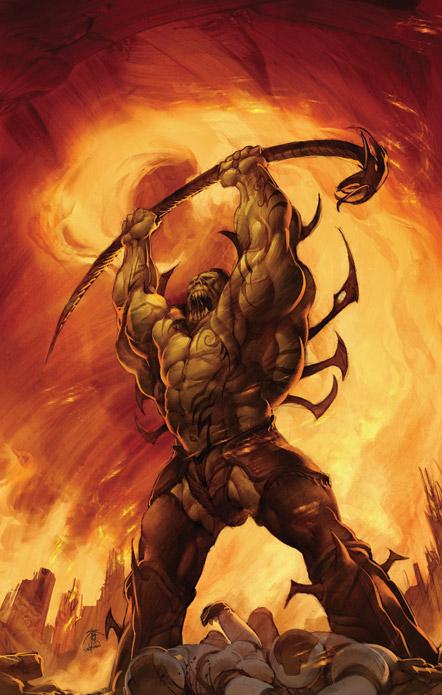
STAR WARS: INVASION #3
Writer: Tom Taylor Art: Colin Wilson Publisher: Dark Horse Comics Reviewer: Mr. Pasty
The Star Wars universe continues to live on (sans Lucas) in the pages of Dark Horse Comics and its latest offering, INVASION, is a valiant effort that unfortunately suffers from its inability to break free from the source material. Now I for one am all about light sabers and blasters and even shooting the occasional womp rat back home, but I haven’t been following the Star Wars comics with any sort of consistency, so imagine my surprise when my first book in many moons centers around – you guessed it -- a master and an apprentice.I just don’t understand how storytelling in a universe so rich with diversity in both characters and locales must always regress to the same tired story of a wise old Jedi trying to mold a bratty young up-and-comer. Is there some kind of Lucas-clause in the creative license that dictates the direction of each book? On the plus side, the master in question is none other than Luke Skywalker, who over time built a “New Jedi Order” to keep peace throughout the galaxy. That right there is something I would be interested in reading about, especially considering that Luke is running around in a black paramilitary Onesie instead of the requisite dirty burlap bathrobe. Heck, I could even go for a CHEERS style sitcom at the Mos Eisley Cantina. But no, Luke is saddled with “Finn,” a ne’er-do-well who will hopefully do well when Luke drops him force-first into a raging battle on his home world. Like most distant planets in Star Wars, this one is populated with people and monsters of all different shapes and sizes.
That’s where INVASION is the strongest. Once it sheds the regurgitated premise for some good ol’ fashioned butt-kicking, both Taylor and Wilson begin to shine. There is a technical competence here from both parties that I think would really excel under different circumstances and well, you don’t just get the keys to the Lucas Cadillac and start flooring it, so I can appreciate what they’re able to do within the confines of the current framework. I’m also not completely lost on the level of hotness possessed by INVASION’S heroines. Like Leia before them, they aren’t a bunch of buxom blondes with giant cans and shoulder-mounted rocket launchers. In contrast, they have an understated beauty that gets amplified when the bad guys turn up the heat and our ladies use some “force.” Pasty likes.
In the end, INVASION is a serviceable – albeit familiar-- addition to the Star Wars collection. The good news is that INVASION brings you everything you’ve come to expect from the Star Wars universe. The bad news is that INVASION brings you everything you’ve come to expect from the Star Wars universe. If this material is ever going to rise above the memory of a once-great franchise, it needs to get knocked out of orbit and start hurtling in a different direction. No one will ever get tired of seeing the Star Wars characters we all grew up with, but unless they’re given something interesting to do, they’re nothing more than clunky mannequins propped up in animated windows as an excuse to sell the Lucas license to casual fans who might not know any better.
Final word: The Empire Strikes the Phantom Menace.
Web heads who can’t get enough of Mr. Pasty’s word vomit are encouraged to watch him operate as Nostradumbass over at here. MMAmania.com. Love, hate and Mafia Wars requests should be directed here.
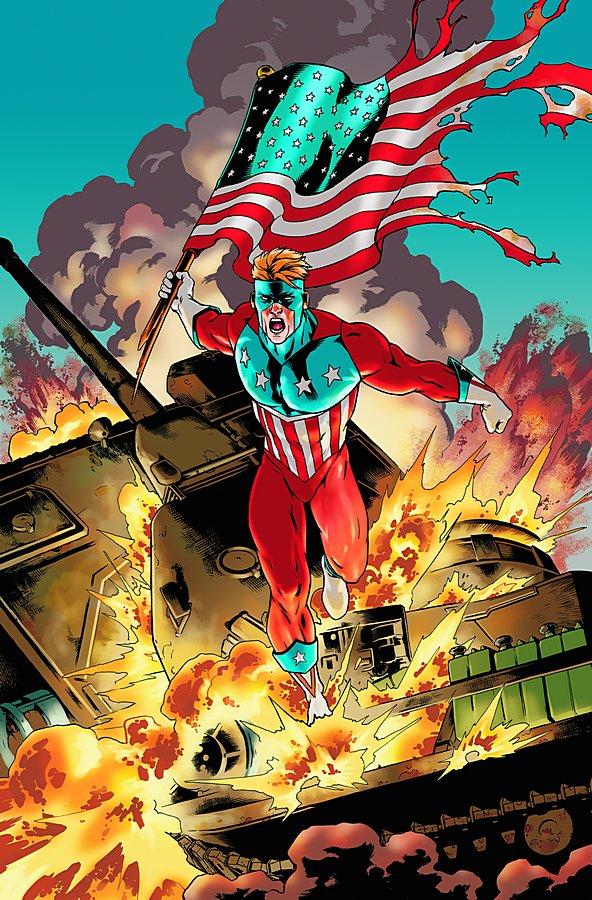
THE RED CIRCLE: THE SHIELD # 1
Written by J. Michael Straczynski Art by Scott McDaniel and Andy Owens Published by DC Comics Reviewed by Stones Throw
One thing you can say about those crazy folks at the House of Ideas is that their hype machine is way better than DC’s. Can you imagine if Marvel had tempted a big name DC writer—say, Geoff Johns—that had fallen out with the DC editorial and crossed the bridge of fire (or whatever it is that separates the two companies) to revive some mostly forgotten characters that the publisher had just acquired? Miracleman/Marvelman created an Internet shitstorm and it isn’t even clear what Marvel are going to do with him, or if they’ve even got the dude at all. My guess is that we’d be so up to our ears in Internet coverage that it would be all comic book fans could do not to stumble away from their computers muttering the words “Red Circle…Red Circle…” over and over again, in a daze.But alas, the longed-for return of the Archie heroes is taking place at the more turtle-like (compared to Marvel’s hyperactive hare) DC, so I wasn’t even aware that JMS’ DC work had started until I happened to see THE WEB and THE SHIELD on the stands next to, uh, WOLVERINE and SHE-HULK. As it is, coming in cold, sans too much fanfare and publicity, the comics remind me of Grant Morrison’s SEVEN SOLDIERS series, the main differences being that the characters Mr. Straczynski has to work with aren’t as interesting as those chosen by Morrison, and that JMS is the more solid, traditional sort of writer, contrasted with the more fitfully brilliant and experimental Morrison. We’ve got new origins for a group of relatively obscure superheroes, a series of #1 issues, and connections gradually being drawn between them towards mysterious and unrevealed ends.
There’s also an attempt to update the fairly unremarkable clutch of characters and differentiate them from the rest of the DC Universe by including contemporary motifs in their modus operandi and raison d’être, meaning in a few years they’ll be horribly dated and fail to cement places alongside Batman, Superman et al. Thus “The Web” can be contacted by logging on to a website that links to his crime fighting suit, which unfortunately also reminds me of themes Grant Morrison was working with in SEVEN SOLDIERS, particularly the Bulleteer character (also, how do those in peril manage to get their iPhones or Blackberries out, while being mugged or assaulted, in time for the Web to appear instantaneously, as depicted in THE WEB #1?).
So, on to THE RED CIRCLE: THE SHIELD #1. We open with our hero, Lieutenant Joseph Higgins, who’s stationed in Afghanistan and has to go stop and search a group of vehicles that are heading towards his battalion and might be dangerous. Given the headlines appearing in our news lately, this is a tense situation, and it’s the kind of opening that should throw you right into the action, without much by way of explanation. But for the first two pages, that clichéd caption box narration took me right out of the action by adding a parallel train of words in addition to dialogue—and simply being too heavy handed.
Our job is to interdict and stop illegal arms shipments into Afghanistan.
Fair enough, but the reader could have worked that out for himself by the dialogue between the two soldiers in the very same panel.
But it’s only a matter of time before our luck runs out. Maybe tomorrow. Maybe the day after. Maybe today.
What’s that, if not a giant nudge and wink as to where this standoff is going? Come on, JMS, know when to shut up and let the story speak for itself. You wouldn’t mix voiceover and dialogue so heavily in one of your movie scripts, would you?
Moving swiftly past minor gripes over use of the form, the convoy is predictably revealed as a trap and the battalion is ambushed, with disastrous results. Lieutenant Joseph Higgins is barely alive, so he’s the perfect lab rat for the US Army to bond its new “Shield” technology to, granting him flight and super strength. This is where a writer like Grant Morrison would go nuts with the physical, mental and political consequences of mixing experimental military technology and live subjects (like he did in WE3), but JMS isn’t really interested in stepping outside the superhero tropes and so the Shield’s origin isn’t any more complicated than those of, say, Captain America or Iron Man, which I suppose has its own appeal in these times of deconstruction and complication. In a hilariously old school bit, the science behind the Shield’s powers is explained in one giant speech balloon: “We were able to literally merge the epidermal layer of the subject’s skin with a new form of nanotechnology…”
There is one hawkish general who says stuff like “If all [our soldiers had this technology] there’s not ONE country out there that would DARE take us on. Not. One.” Umm … isn’t that already the case? Isn’t that why the US is at war with a bunch of hairy rebels in Afghanistan? Because no one else will ever take them on in conventional warfare?
Although you can probably count on a scene in which Lieutenant Higgins goes against his political masters, THE SHIELD doesn’t seem too interested in addressing the more scary side of a flag-clad super soldier blowing the hell out of bits of Afghanistan. So if you’re interested in a straightforward action story that ignores the more weighty themes dealt with in comic books in the past few decades and has more in common with the Commie-bashing of 1960s Marvel and DC and features a generic patriotic character from Archie Comics, this is the one for you. Thanks to the lack of hype, everyone else will probably give it a miss.
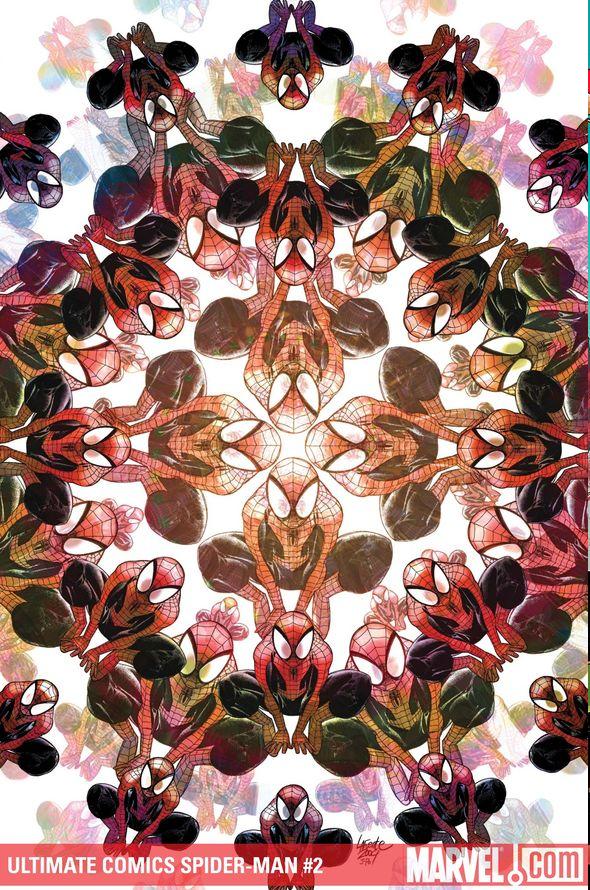
ULTIMATE COMICS SPIDER-MAN #2
Writer: Brian Michael Bendis Artist: David Lafuente Colorist: Justin Ponsor Publisher: Ultimate Marvel Comics Reviewer: Matt Adler
Ok, the title on the cover and the indicia is simply ULTIMATE SPIDER-MAN, but there’s no mention of “Volume 2” and the solicitations have it as ULTIMATE COMICS SPIDER-MAN, so for purposes of distinction, I’m going with that as the official title. Confession time: I haven’t followed ULTIMATE SPIDER-MAN since somewhere near the end of the Mark Bagley run. There are a number of reasons for that.My recollection is that Bendis’ style was wearing a little thin on me around that time, and I was getting bored of “Ultimate versions” of established characters being introduced each issue that didn’t seem very new or interesting. The storylines didn’t do anything for me either, and the book seemed to have lost its focus from the early issues when it was about Peter and his relationships. Add to that the news that Bagley would soon be concluding his run, and I wanted to put my dollars towards some very good books that weren’t assured of continued publication, like USM was. I preorder my comics each month, and I think at one point on seeing the solicitation for the latest USM collection, I just decided “Eh, I can skip it.”
So now comes the relaunch of the Ultimate line, and with it a new volume of ULTIMATE SPIDER-MAN. I’ll start with the art since that’s the biggest change. To put it bluntly, it’s not my cup of tea. It’s very manga-ish, and while the manga style has grown on me over the years, it’s not what I want to read in an ongoing Spider-Man comic. I grew up with Mark Bagley, and in many ways his version of Spider-Man is the standard against which I measure any other modern takes. His sleek designs and dynamic action sequences have always made for fast-paced, visually exciting Spider-Man comics. And he always strikes just the right balance between realistic and stylized. But David Lafuente’s manga version just takes me out of the story. His Spider-Man does not look like the athletic, agile hero who through sheer speed and acrobatics can take down foes many times stronger, and the cutesy manga expressions he gives several characters just seem out of place. Mary Jane also appears to have turned into Janeane Garofalo.
Ultimate Mysterio (who apparently made his debut in an Annual some time back) has an interesting design which is reminiscent of the short-lived Mysterio redesign that was used in the Clone Saga. I remember Tom Brevoort saying that they abandoned that design because they felt it made him look too much like Dormammu, but in any event it works pretty well here, better than the fishbowl and green pajamas. Mysterio here seems to be some sort of anarchist, looking to terrorize and unravel society; he started last issue by offing the Kingpin. I think this is a bad move for the book, since the Kingpin was a crucial part of one of the best USM stories early on, and would’ve made a great ongoing antagonist for young Peter.
There are a lot of status quo changes that I’m unfamiliar with, having been away from USM for so long; somehow, Gwen Stacy is back. Last I knew, she had been killed by Carnage. I recall there was a lot of fan outcry over that, so maybe that’s why it was reversed. The Daily Bugle is gone (wiped out in ULTIMATUM along with the rest of the city, although the entire city has been rebuilt in 6 months), so Peter now works at a fast food joint. Also, having not read ULTIMATUM (and I’m told I’m fortunate for that), I didn’t know about this new “using mutant powers is outlawed” thing; how does that work for mutants who can’t turn their powers on and off, like, I dunno, Rogue? The other major status quo change for the book is that apparently as a result of Spidey’s very public heroics during the Ultimatum crisis, he’s now beloved by the authorities. That can’t last for long, though.
Despite some of my reservations, I have to say that Bendis is pretty consistently good when he focuses on character stuff, as he does in this issue. There’s some great, funny dialogue exchanges between Peter and a mom and daughter supervillain duo; the young daughter has an exceptionally foul mouth, while the mother is trying to coach her in the proper way to execute a crime.
There’s some good stuff here, and I have a feeling the art may work better for a younger generation (and that may be who they’re aiming for), but for myself, I honestly can’t justify getting this book on a regular basis again. It just doesn’t have the spark for me that once made USM one of the first Spider-Man comics in years I could really get into.
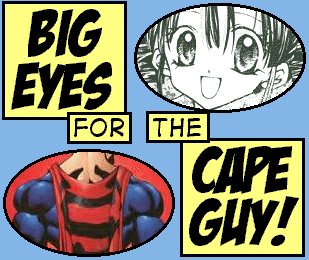

MARIA HOLIC Vol.1
By Mundi Endou Released by Tokyopop Reviewer: Scott Green
While generally disinterested in teen/gender comedy anime/manga, I did have an eye out for MARIA HOLIC. I had caught Tatsuya Oishi's imaginative and humorously naughty opening to the anime adaptation. The trailer that Mediafactory put together wasn't bad either. What clinched by hopes for what I'd normally find was some pictures from a bonus section of the manga that had also looked cleverly absurd. I came away less than impressed by Mundi Endou's sense of what is funny or ability to convey build gag.MARIA HOLIC opems with the familiar ode to the dead mother, not unlike OURAN HIGH SCHOOL HOST CLUB. "Dear mother in heaven... Kanako has finally arrived!! Here where you and father met... I too shall find my soul mate!!" The declaration refers to second year high school student Kanako's transfer to girl's Catholic academy Ame no Kisaki. (Her father was a teacher and her mother was a student. There was an age discrepancy. Yeah, it's creepy.) And, the manga quickly introduces the reasons to derive mirth from Kanako: she's tall (5'8") and she likes girls. She's also self conscious about both of these elements of her identity. Her ability to mask her preferences is not helped by the familiar-in-manga visual gag of spouting blood from her nose when she needs a girl she finds attractive, and in a less familiar twist, she breaks out in hives when she comes in contact with boys.
Matters appear to be off to a rocky start when she wanders onto the campus only to be greeted by a stiff young woman in a maid’s outfit who welcomes Kanako with "what's a SWINE like you doing in a place like this?... That's right, I'm talking to you giant pig. You're as tall as the Eiffel Tower." Luck seem to swing into positive territory when she runs into Mariya Shidou, a pleasant girl in pig tails and the school uniform of the junior high connected to Ame no Kisaki. Not only is she cute, she's well off. Unlike hardscrabble Kanako, Mariya's family estate overlaps school grounds. Furthermore, Mariya expresses enthusiasm towards Kanako's life story. When told about Kanako's parents meeting at the school "how wonderful! The Virgin Mary must have brought the two of them together." Kanako's heart leaps for joy when she discovers that Mariya doesn't have a boyfriend. "Oh mother in heaven! I might have found my soul mate already! Mariya Shidou... your name... you face... Everything about you is brilliant and beautiful!" Then Kanako notices hives on her wrist...
Kanako checks into her dorm, where she's abused again. The dorm matron proves to be a girlish figure with cat ears accompanied by a dog wearing an apron. In a less than pleasant or expected exchanged, the matron informs Kanako that she is to be referred to as "boss or god" noting that "defiance means death."
Then, Kanako stumbles onto Mariya being fit into a corset and falsies... and the reason for the earlier hives is revealed. The conceit here is that Mariya is a mean spirited boy who has adopted the persona of a sweet, helpful girl in order to become the chair of both the girls school and the sibling boy school once chaired by her grandmother. Fearing that Kanako might out his/her true gender, thereby forcing her out of Ame no Kisaki, Mariya responds by ripping open the blouse of her maid and threatening to frame Kanako as a predator. Even as absurd manga comedies go, this one strains credibility in its distance from believable motivation or action.
If you find these concepts amusing, then you have a fighting chance with MARIA HOLIC. The manga runs in MONTHLY COMIC ALIVE, a seinen (older teen to adult male targeted) anthology, along with other cute girl series, in numerous cases adapted from eroge games. As such, the perspective of the reader is not expected to align with that of the subjects. The reader is position to gawk and judge rather than empathize with the characters.
If you're not inclined to smirk at the tribulations of girl design to appear cute to that MONTHLY COMIC ALIVE audience, the manga does little bridge the deficit. Unfortunately, Minari Endou does not display an aptitude towards comedy in this volume. Compared to the character cartooning and pacing of Shizuru Hayashiya's Hayate x Blade or Koji Kumeta's intelligent way of conveying even obscure jokes in Sayonara, Zetsubou-Sensei, Endou is seen to simply rest on ideas assumed to be funny. And, the fundamental assumption that defines MARIA HOLIC is that presumably transgressive behavior, such as a girl liking girls or a boy dressing as a girl, are inherently funny. Endou tries to embellish the gags, but shifting the level of abstraction in the character designs and adding a few visual effects does not do the trick.
One chapter revolves around a student assembly that becomes an opportunity for Mariya to win over the audience and advance her aims of becoming the school chair. Kanako disturbs the assembly with her growling stomach, but Mariya covers for her in such a way that the other student both let up on Kanako and credit Mariya's act of kindness. As Mariyama leaves the stage, she trades barbs with her rival. "Nice speech flat-chest." "Thanks a lot fat-ass." Cut to panels of Mariyama and rival forcing smiles with veins bulging, against a black background, crackling with sparks - one with hands to chest, the other with hands to posterior. Accounting for the subjective nature of humor, I have to say that I don't think that chapter's jokes were funny, nor do I think Endou accomplished much in pushing the material beyond its inherent humorousness. The assembly situation is par for the course. As such, I don't think I as much as cracked a grin throughout the volume.
The "food is terrible and the portions are too small" criticism of MARIA HOLIC is that is the page reproduction in the book is painful bad, possibly exacerbated by paper quality. Manga released by a major publisher in 2009 should not have pages that look as muddy as ones in MARIA HOLIC. Without exaggeration, there are pages where faces look obscured by shadows, which in the Japanese version are merely shaded. If MARIA HOLIC approached the cleverness that I expected, this would only be an annoyance, but when reading the manga turned into a grind, the production problems added insult to injury.
Scott Green has been writing for AICN ANIME for over eight years. If you like what you see here and love anime & manga, be sure to check out his latest AICN ANIME column every week on AICN.

Hey folks, Ambush Bug here. We’ve got three stellar samplings of indie awesomeness this week. Any one of these books can be considered the best of the best. I had trouble figuring out which one I like better. Check out these comics with indie flavorings.
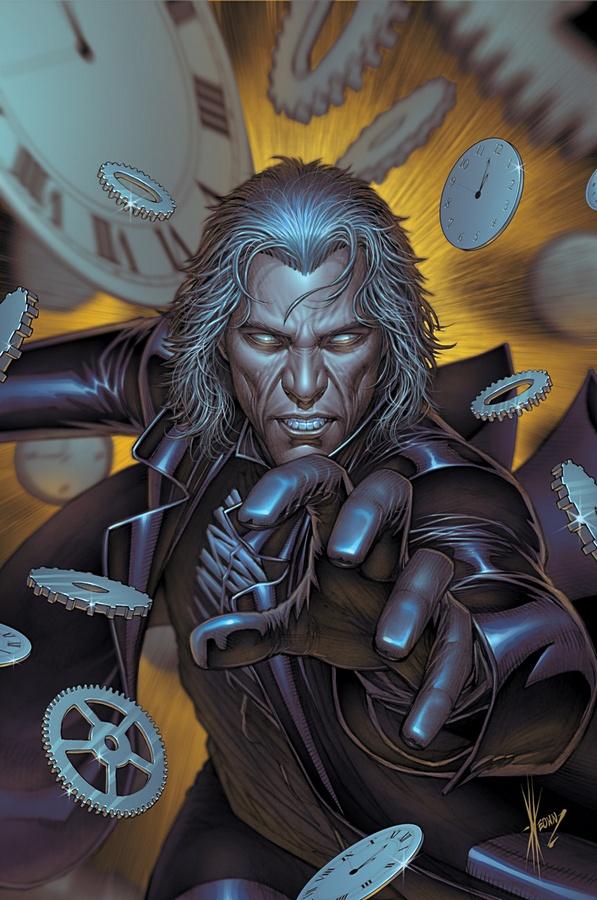
RODDENBERRY PRESENTS DAYS MISSING #1 Archaia
I’m jumping onto this one a bit late in the game, but I’m just starting to catch up on all of the stuff I got from this year’s SDCC. This comic blew me away when I read through it the other day. But I shouldn’t be surprised. Phil Hester is quickly becoming one of the most original and must-read writers out there today. His comics are as varied as they are entertaining and with Frazer Irving along for the ride supplying the art, this is a surefire hit. The story is purposefully vague as to what exactly he main character is. Is he an alien? A god? An immortal? All the reader knows is that he’s been around since the dawn of time and has taken the awesome responsibility of stopping the human race from wiping itself out. But he’s also doing this for selfish reasons. You see, since the guy’s been around for so long, he has waited a long time to converse with other people such as himself. Now that humans are here on this planet, he doesn’t want them to go because that means he’s going to be pretty lonely again. Issue one focuses on a plague that is rapidly spreading through Africa and threatens to move to the rest of the world, wiping out the earth’s population in its wake. It’s a high concept and in twenty two pages, this book travels all over the world and throughout time. This book is one of those dense reads that makes you count the number of pages when you’re done to see if they slipped a few in there without anyone noticing. The art can’t be beat. Frazer Irving’s trippy visuals are mind blowing. The guy simply draws everything amazingly, from dinosaurs to warzones to small crying children. This is sci fi at its best and well worth checking out.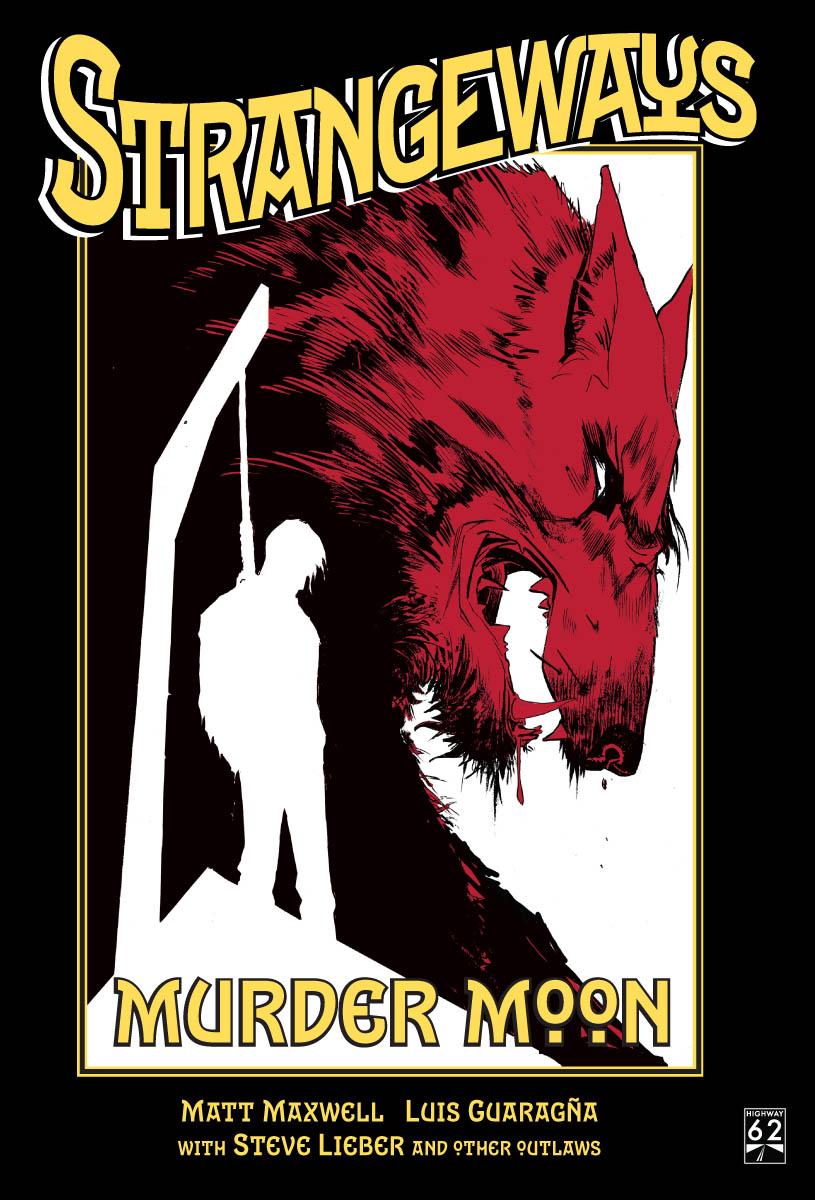
STRANGEWAYS: MURDER MOON TPB Highway 62
I’m a sucker for a good genre mash-up and this is one cool genre mash-up. The best mash-ups are able to stand on their own in both genres and this one does just that. STRANGEWAYS could be a damn fine western book. Writer Matt Maxwell does a great job of making the stories read well. The dialog seems authentic. Not all DEADWOOD poetic, but genuine to the time and era. Lines like “That wolf’s taken more bullets than Gettysburg” make me smile. But the other aspect of STRANGEWAYS makes it stand out as better than most. There’s an even helping of horror on top of all of that Western fun. And it’s the scary kind of horror, not the gross-out kind. This one works as straight up horror too. MURDER MOON focuses on a pair of cowboys, one of which is bitten by a werewolf. The other vows to hunt him down and try to help his friend if he can or put him down if he can’t. The art by Luis Guaragna helps add that eerie feeling to the dark territory the wolf and the cowboy are trekking across. Deep shadows and a pretty vicious looking werewolf make this one of the cooler lycan stories I’ve read in a while. The trade also has a short story in the back with art by Gervasio and Jok--a short that is just as powerful and creepy as the main story. Writer Matt Maxwell seems to have a great hold on both genres. This looks to be the first of a series of creepy western tales and I’m looking forward to reading more of them in the future.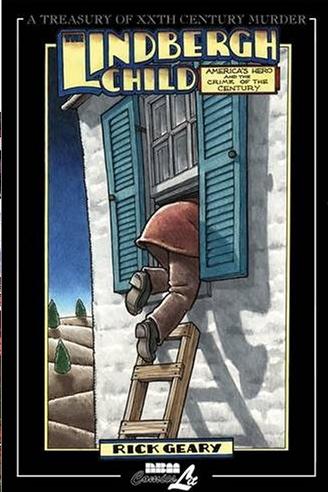
THE LINDBERGH CHILD OGN NBM Comics Lit
Man, I love, love, love the works of Rick Geary. I just discovered the guy's work with this writer/artist's stories a while back with the FAMOUS PLAYERS hardcover, but you can officially put me in the category of avid fan after reading that amazing mystery graphic novel and this one as well. I got to meet Mr. Geary at SDCC this year and when I asked him which is the favorite graphic novel that he put out, he pointed me to this one. After finishing it, I have to agree. This is one awesome read. For those of you who don't know Geary's style, think of the narration before MAGNOLIA or THE ASSASSINATION OF JESSE JAMES and you pretty much have the voice I hear when I read Geary's books. Told mostly in caption, Geary's panels rely on stating facts rather than playing them out in scene (although the few scenes played out in this graphic novel are simply riveting) which give a sort of cold narrative feel to the book, as if it were being read to you by an inscrutable undertaker. But that doesn't mean it's a boring read at all. The cold delivery of the story only makes the mystery that much more chilling, amplified by Geary's beautiful black and white panels that never leave out important details while still maintaining elegant simplicity. I didn't know a lot of the Lindbergh Case going into this book and I'm glad I didn't. Not knowing how it all ended added to the intensity and made the ending all the more powerful. Those who long for a good mystery should seek out Geary's work. His depiction of the Lindbergh case is now etched into my brain and I can't wait to read another one of this modern master of mystery's real life whodunnits.

